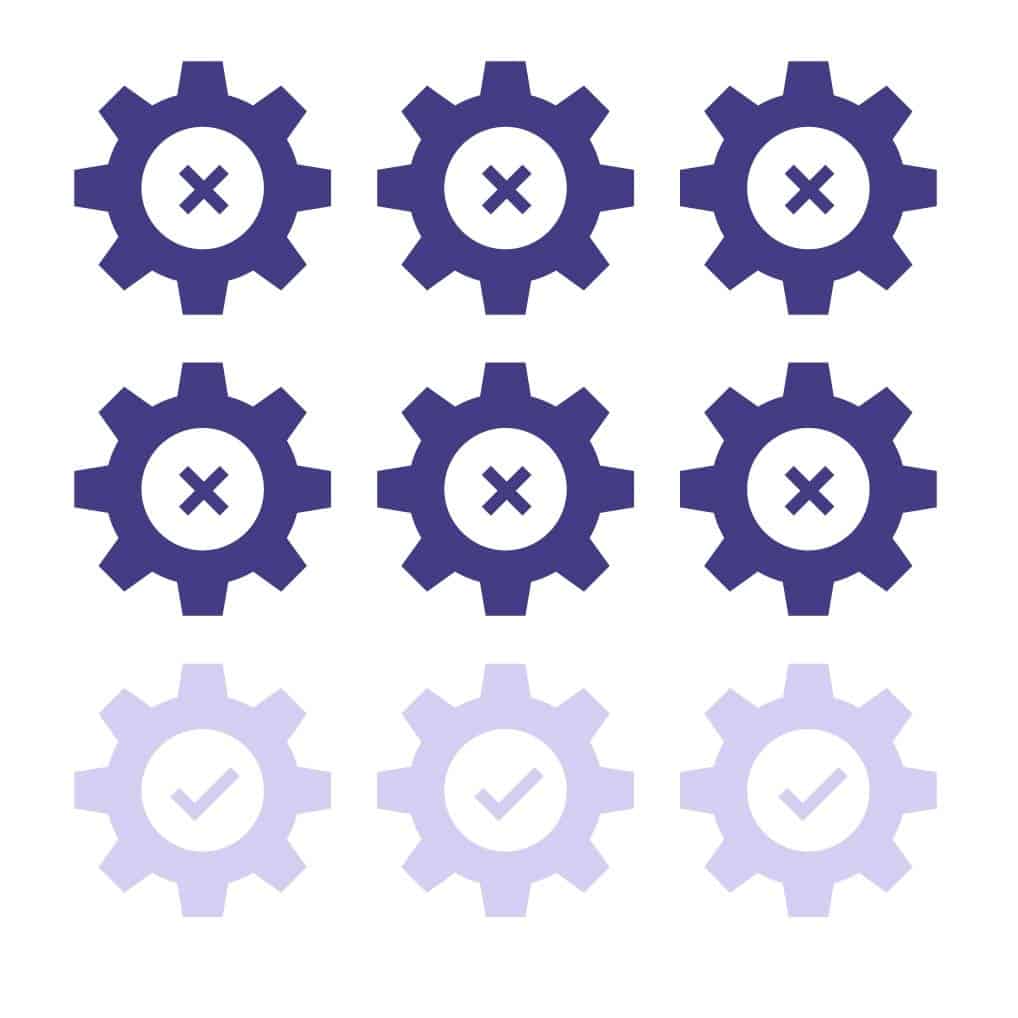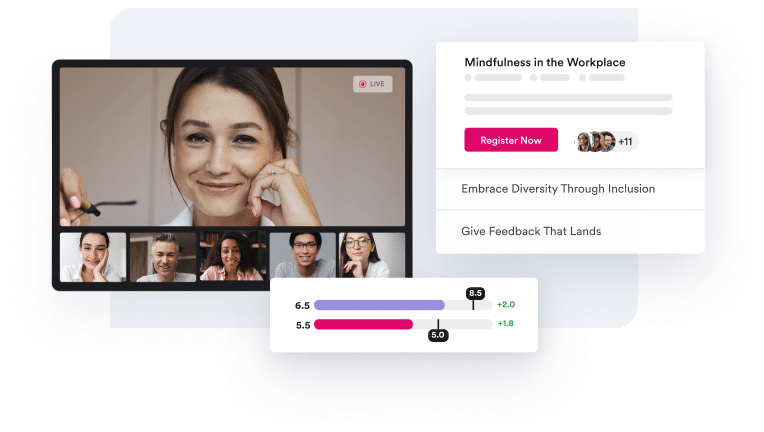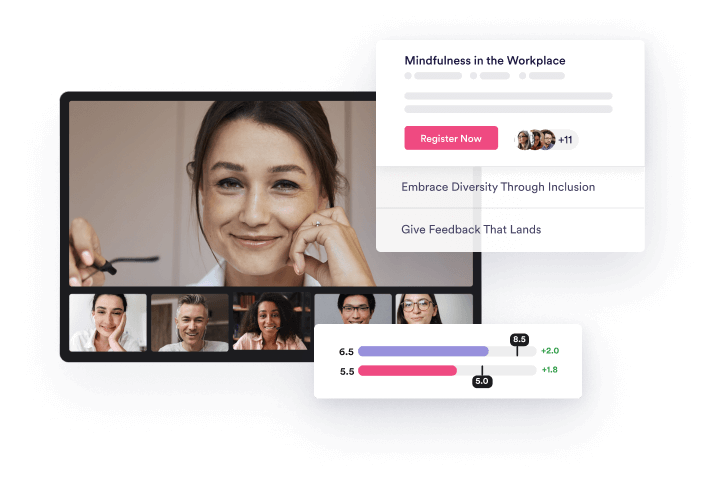Ask any HR leader which skills their company desperately needs to invest in, and they’ll more than likely point to power skills. Things like effective collaboration, emotional intelligence, and adaptability are the difference makers in today’s workplace. Studies show that 85% of job success actually depends on these skills.
But here’s the bad news: 83% of companies see gaps in these skills among their employees — especially in critical thinking, problem-solving, leadership, and communication. Without these skills, you’re looking at lower productivity and higher employee turnover. Businesses are on the clock to develop these skills to keep up in today’s fast-paced, ever-changing world.
When companies train their people in these power skills, it’s like hitting the jackpot. Not only do employees level up in their careers, become more productive, and feel happier on the job, but the company’s bottom line gets a boost, too. Studies show that this training can increase productivity by 12% and deliver a 250% return on investment.
What is driving the need for power skills?
The business world is evolving faster than ever, thanks to new technology, market disruptions, tougher competition, and shifting customer expectations. Employees must be flexible and agile. They’ve got to pick up new skills fast, adjust on the fly, and navigate uncertainty.
Let’s look at five key trends increasing the demand for power skills.
Automation and artificial intelligence
Automation and AI are handling more routine tasks and changing the nature of our work. This allows employees to develop uniquely human skills, like creativity, critical thinking, emotional intelligence, and interpersonal skills.
Remote and hybrid work
The shift to remote and hybrid work has highlighted the importance of effective communication and remote team management. Employees must be highly skilled at maintaining productivity and team collaboration without consistently being in the office.
Changing workforce composition
Five distinct generations coexist in today’s workforce. Power skills are a universal language that bridges differences and facilitates effective communication, collaboration, and conflict resolution.
Globalization and diversity
Teams today span different cultures, backgrounds, and time zones. Navigating this effectively requires strong cultural competence, empathy, and communication skills.
Changing customer expectations
Customers expect personalized experiences, prompt issue resolution, and genuine engagement. Employees must have strong communication, empathy, and problem-solving skills to deliver exceptional customer service and build lasting relationships.
Leadership is evolving
Decentralized leadership models and skills-based organizations are changing the workplace. Leadership may be distributed, and there is a focus on expertise rather than job titles. In these workplaces, power skills are essential for promoting innovation, agility, and individual success.
Power skills are critical at every level
From individual contributors to senior leaders, developing power skills is essential for navigating the complexities of the modern workplace. But we often see investments in upskilling these areas confined to managers and senior leaders.
The problem? Most of your workforce is individual contributors (ICs) — and 62% want to remain ICs.
Sierra Quiros, Senior Manager of Talent and DEIB Programs at Betterment, put it best: “ICs are often overlooked when it comes to power skills training. But how often is an IC asked to ‘manage up’ or give feedback to their peers? ICs need many of the same skills we teach managers — but our solution is almost always just to train managers to figure it out. We’re not giving ICs the same opportunities to learn those skills and grow as people, which is great for the workplace as a whole.”
For every managerial skill, there’s a complementary skill for team members. If you teach a manager how to give effective feedback, the ICs on their team need to be open to feedback and know how to receive it. When leaders learn to manage change effectively, their teams must understand how to embrace agility and cope with change.
Additionally, ICs are on the front lines, working with customers, selling to prospects, and executing company objectives. So, it’s important to long-term business performance that they are also proficient in these skills.
In fact, businesses that extend leadership training to all employees, regardless of managerial aspirations, are 4.2x more likely to outperform those that don’t in revenue growth, operating margin, and return on equity.
These organizations also experience benefits like:
- More effective collaboration driven by improved communication, active listening, and better working relationships, which could save your company $1,660 per employee annually in productivity gains
- A positive work culture where everyone feels valued, respected, and supported — which leads to improved morale, higher job satisfaction, and lower turnover rates
- Increased internal mobility by developing leadership skills — like communication, emotional intelligence, and problem-solving — across the organization, which strengthens the leadership pipeline and ensures continuity in leadership roles
- Improved customer service from upskilling in active listening, empathy, and conflict resolution because employees can better understand customer needs, address concerns effectively, and build relationships
- Adaptability to change because employees can more quickly adjust to new technologies, processes, and market conditions, which helps the organization stay competitive
The bottom line: Compelling stats on 7 of today’s most critical power skills
But how exactly do power skills impact business performance? They massively improve employee productivity and performance, which turns into dollars for the business. Don’t take our word for it; check out the research below.

|
Manager effectiveness greatly influences productivity, with research suggesting that employees with ineffective bosses waste between 10% and 52% of their time at work. |

|
Communication is pivotal for smooth business operations, and poor communication can be costly. Business leaders estimate poor communication in the workplace leads to a loss of 7.47 hours per employee per week — this translates to more than 18% of total salaries paid. |

|
Collaboration is essential for team success, but ineffective collaboration can result in significant productivity losses. Studies show that 70% of employees feel poor collaboration wastes their time, with 64% reporting up to three hours lost in productivity each week and 20% indicating a loss of six hours. |

|
Change management falls short more than 70% of the time. Employee resistance and inadequate support from management result in change programs that often fail to meet their objectives. |

|
Inclusion fosters employees’ sense of belonging and commitment, yet many individuals feel isolated. Research indicates that 40% of people experience isolation, leading to lower organizational commitment and engagement. |

|
Conflict management is another area where businesses can experience significant productivity losses. On average, employees spend a mind-blowing one workday per month engaged in unproductive conflict. |

|
Effective feedback is critical for employee development and retention. Companies that implement regular employee feedback experience nearly 15% lower turnover rates. |
Challenges L&D leaders face when investing in power skills for individual contributors — and how to overcome them
Even with these crystal clear business benefits, HR and L&D leaders face challenges when they try to justify the investment, especially when they’re looking to invest in upskilling ICs.
Challenge #1: “I don’t have enough time or budget to deploy power skills training to all of my ICs.”
To overcome this challenge, L&D leaders must demonstrate the tangible benefits of power skills development. Highlight how investing in training can lead to increased productivity, higher employee engagement, and better retention rates. By showcasing these outcomes, L&D leaders can make a compelling case for prioritizing resources toward ICs’ training needs.
Use the stats and research from earlier in this article to help you make your case!
It’s also important to explore cost-effective solutions. Not all training programs need to be expensive to be effective. L&D leaders can look for innovative ways to provide training and development opportunities tailored to every level of the organization, including ICs. Look for solution providers with flexible training options and content for employees at all levels.
Challenge #2: “I can’t seem to convince my leadership team that the investment is worth it.”
It’s crucial to emphasize how power skills contribute to career advancement and overall job performance. Statistics highlighting the connection between power skills development and improved productivity, employee satisfaction, and organizational success can be compelling evidence in making this case.
Providing concrete examples of success stories can also help sway skeptics. Sharing anecdotes from peers or industry leaders who have experienced firsthand the benefits of similar training programs can illustrate the potential impact on individuals and teams.
This article includes some great tips from seasoned L&D leader Jenny Dearborn.
James Castrillon, Senior Talent Development Manager at a leading company in the tech and analytics space, highlights the importance of securing buy-in for these initiatives. He notes, “To secure buy-in for offering these trainings, we emphasized tailoring the content to meet specific team needs and offered flexibility with scheduling to address concerns around timeline and time commitment.”
By aligning training content with team requirements and accommodating scheduling preferences, L&D leaders can boost the likelihood of getting support for power skills training initiatives.
Challenge #3: “I’m struggling to align my power skills training with concrete business objectives.”
Early engagement with stakeholders is crucial to ensuring the success of power skills training initiatives. This involvement allows stakeholders to understand the importance of the training and its alignment with organizational goals, increasing their willingness to invest resources and champion the initiative.
Sierra from Betterment emphasizes the need to establish a strong business case for these programs. She says, “Programs will not be picked up if they don’t have a business case. Get in touch with your stakeholders, do a listening tour, talk to your employees, execs, and department heads, and hear where the gaps are — and where and why ICs feel like they’re being overlooked.”
By conducting thorough assessments and engaging in meaningful dialogue, L&D leaders can identify areas for improvement and tailor power skills training initiatives to address specific business needs.
Challenge #4: “It’s hard to measure the effectiveness and outcomes of the training.”
Metrics to measure training effectiveness may include employee satisfaction surveys, performance evaluations, and feedback from managers and peers.
A comprehensive approach combining quantitative and qualitative measures is essential. Quantitative data provides numerical insights into the impact of training, while qualitative data offers valuable context and depth. Anecdotal evidence and case studies can complement quantitative metrics, giving real-life examples of how power skills training has positively influenced individual and team performance.
James recommends launching surveys following each program to gauge feedback and make revisions based on the trends they see that align with their organizational needs. He says, “Regularly evaluating the effectiveness of the programs offered through surveys and in-person feedback is crucial to continue improving them.”
Similarly, Sierra from Betterment outlines a comprehensive approach to measuring the impact of training programs. She explains, “In addition to pre- and post-program surveys and Hone class feedback, we also do small-group roundtables to have a live discussion around what worked well, what didn’t resonate, and ask clarifying questions.” Sierra has also built close relationships with her HR Business Partners, who consistently evaluate engagement surveys and performance levels on the teams they work with to identify needs and skills gaps.
Challenge #5: “I don’t know how to satisfy all the different needs across roles and levels in a scalable way.”
To overcome this obstacle, conduct a needs assessment to identify the power skills required for different job functions and levels. Once you’ve identified the specific needs, the next step is to develop tailored training programs or modules.
James emphasizes the importance of collaboration with stakeholders in developing tailored training programs. He shares his experience, stating, “I partnered with my leaders and did a global kick-off with the functional heads to provide an overview of the content. Stakeholders were then involved in helping us revise the content to include real-life scenarios.” This approach highlights the value of involving key stakeholders in the process, including functional leaders with firsthand knowledge of their teams’ challenges and requirements. This approach highlights the value of involving key stakeholders in the process, including functional leaders with firsthand knowledge of their teams’ challenges and requirements.
This challenge can be difficult to overcome because it requires a more significant lift from the L&D team. Partnering with learning providers that can help you tailor learning programs and content for your various teams is essential.
Future-proof your organization with power skills training for all
As work becomes more high-tech and unpredictable, strong power skills will be even more crucial. It’s not just about knowing how to complete tasks anymore — it’s about how well we work with others and adapt to new situations.
By making power skills a priority for everyone in the organization, from ICs to VPs, businesses can set themselves up for success. They’ll create happier, more effective teams and be ready to tackle whatever the future brings.








